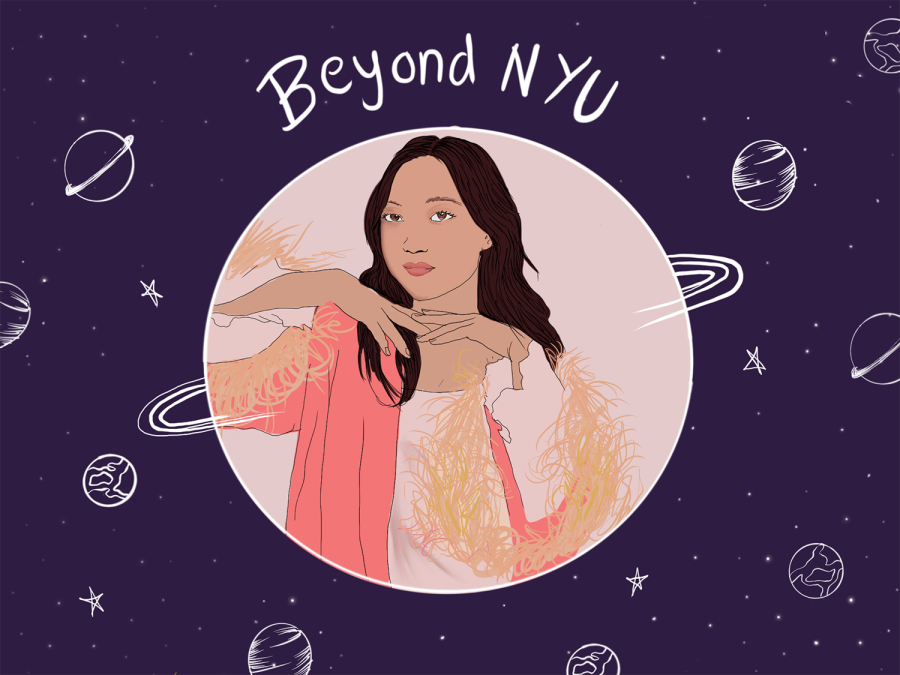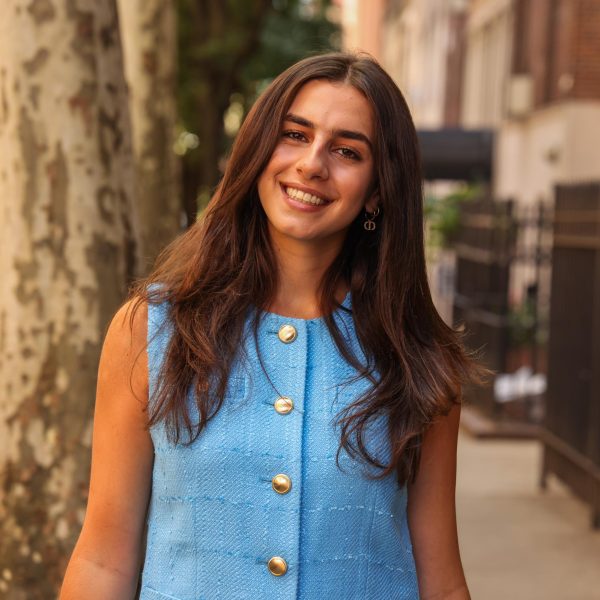Beyond NYU: Designing sustainable style
Olivia Cheng created her clothing brand, Dauphinette, after a trip to France. Despite having little prior design experience, her clothes have now appeared at the Metropolitan Museum of Art and at New York Fashion Week.
(Illustration by Aaliya Luthra)
February 23, 2023
Stern alum Olivia Cheng, now a designer, founded her own sustainable clothing brand, Dauphinette. Despite starting without design experience or connections, she now creates garments made from preserved flowers and recycled components, some of which have been featured at New York Fashion Week and at the Metropolitan Museum of Art.
The idea for Cheng’s brand first came to her on a visit to France when she was 18. In Paris, she walked through the vintage and antique stores of the historic Marais shopping district. A year later, she started upcycling and selling clothing as a business, and now runs brick-and-mortar storefronts in New York City and Los Angeles.
In an interview with WSN, Cheng spoke about how her brand has developed from its beginnings in the south of France, what makes her clothing unique and the message she hopes that her clothes send to clients.
This interview has been edited for length and clarity.
WSN: How did your time in France influence how you source your materials?
Cheng: At the time, I thought I was the only person who knew about Le Marais, and thought it was the coolest thing. I remember just going through the vintage and antique stores and seeing how nobody was looking at the furs or the leathers — the things that built up French fashion over the 20th century. Everybody was leaning into this Americanized idea of sportswear and streetwear, so I began thinking about ways those types of pieces — heritage pieces with such cultural significance — could be reinterpreted for the contemporary market.
Cheng said her trip to France inspired her to experiment with outerwear, specifically with coats. Since she didn’t have much experience in design, she began by painting. About a year later, she went to the Garment District in New York City and looked at factories to see how the clothes were made. There, she learned how to turn a sample into something that could be available in a range of sizes.
WSN: How were you able to launch your brand without design experience?
Cheng: I started with what I knew, which was painting, and the application of various materials — I’ve always had a massive interest in material. I wanted to use coats as canvases not only in a literal sense — some were painted — but I became really interested in how I could apply different types of materials to the coat. I did vintage leather jackets with pressed hydrangeas all over the leather. I would seal them with this waterproof oil paint sealer that is a good archival medium. I would use paint infused with pearl powder to paint a jacket to look more like a vase, because I wanted to make these jackets look like chinoiserie vases with all of the blue motifs.
Cheng had already started working on her brand while at NYU. She said that a public speaking class she took while at the Stern School of Business taught her to appeal to a public audience. She added that she often stepped out of the room during classes to, for example, meet a messenger to communicate with publications covering her brand.
WSN: What was it like working to start a brand while still in school?
Cheng: Sometimes people become very singular and focused. When you are passionate about something, sometimes everything in the world feels like it falls away a little bit — almost like when you are in love. It was like that for me because I had this very specific focus, I knew how much time it would take, and I wanted to dedicate all the time I wasn’t in the classroom to it.
WSN: Where did your brand’s name,“Dauphinette,” come from?
Cheng: For some reason, I wanted the brand name to start with the letter “D.” It has no significance to me, but I think letters like “D” and “S” work well in terms of brand names — they have a ring and punch to them. When I was in France, I was thinking if that had been my initial inspiration for creating this brand, perhaps I could tie it back to the brand name. I was thinking about the word “Dauphin” — the word for the heir to the throne in France, typically the oldest son of the king. I decided to give that word a feminine ending and turn it into “Dauphinette.”
Two of Cheng’s dresses were featured in the Metropolitan Museum of Art’s Costume Institute from 2021 to 2022. Both pieces incorporated floral designs, with one made out of daisies and the other a white design with floral details. The nontoxic flowers in her clothes are from local gardens, farms and locations that hold personal meaning to her. Her clothes have also appeared at New York Fashion Week, Nordstrom and various boutiques.
WSN: Why do you choose to use preserved botanicals in so many of your pieces?
Cheng: It goes back to my attraction to materials and flowers being the most important, prominent and proprietary contribution I can make in terms of materials. What first differentiated Dauphinette was our ability to turn real flowers into wearable pieces. On a personal level, that attraction has always been there. Most people like flowers, but this idea of turning something fleeting in nature into something that is preserved and cherished into a lasting keepsake and heirloom piece shows this thoughtful consideration of the material. You are not just cutting a bolt of fabric, you are thinking about each flower as you preserve it, and turning that into this sartorial contribution.
Cheng was included in the 2023 edition of the Forbes 30 Under 30 list, under the Art and Style category. In the future, she hopes to contribute to the world in addition to her work as a designer. She wants to learn to be sustainable, not just in the products she is making, but as a businesswoman and person.
WSN: What do you hope people feel when they wear your clothing?
Cheng: I want people to feel happy and joyful, but more than those things, intrigued. Yes, a lot of the pieces are conversation pieces, which is fun in that the public can bond over clothes, but I feel like one of the things I am most proud of with our pieces is that they keep the wearer entertained and learning. These days, I think of fashion as one of the many platforms for education, whether that is sculptural, environmental or something else. With our clothes, you get to be so up close and intimate with the materials. You can inspect them and observe them and be curious, which is something we want to hold onto as adults and people moving through the world.
Contact Adrianna Nehme at [email protected].

























































































































































